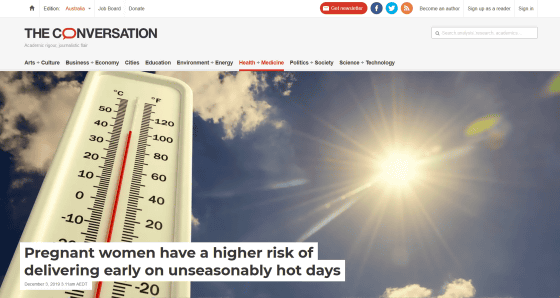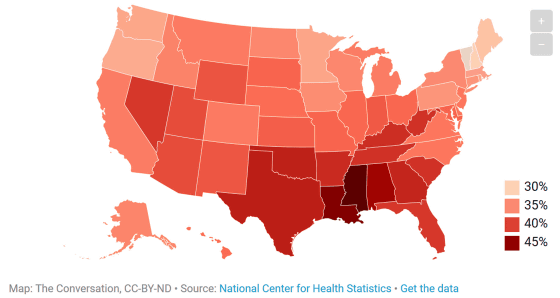Global warming may make it easier for babies to be born earlier than planned

by
A typical gestation period is approximately 40 weeks, and it is recommended that babies spend as close to maturity as possible in their mother's womb. Premature birth, which gives birth much earlier than planned, is also known to increase various medical health risks, but, “If the number of extremely hot days increases due to global warming, more babies may be born earlier than planned. Researchers point out.
The impact of high ambient temperatures on delivery timing and gestational lengths | Nature Climate Change
https://www.nature.com/articles/s41558-019-0632-4
Babies Are Predicted to Be Born Earlier in The Extreme Heat of Climate Change
https://www.sciencealert.com/heatwaves-shorten-gestational-length-and-babies-abandon-ship-quicker
Pregnant women have a higher risk of delivering early on unseasonably hot days
https://theconversation.com/pregnant-women-have-a-higher-risk-of-delivering-early-on-unseasonably-hot-days-126822

In the United States, one out of four people is born 2-3 weeks earlier than planned (PDF file), and there is a
The figure below shows the percentage of babies born under 38 weeks of gestation during the period 2007-2018. It can be seen that the proportion of babies born earlier is increasing toward the south.

However, simply looking at the percentage of babies born early cannot give an accurate survey. According to Barreca, in Mississippi, there
Barreca and his team analyzed 56 million birth records born between 1969 and 1988 against temperature data in the county where the children were born. In the analysis, he said that he investigated how much the number of sunrise births exceeded the county's average number of births on the day when the highest temperature in the county was 32 degrees Celsius.
In general, when analyzing preterm birth, the number of weeks of pregnancy is used as an indicator. However, Barreca pointed out that it is difficult to measure the exact pregnancy period medically, and sometimes there are many ambiguous guesses by the hospital and parents. Therefore, in this study, without using pregnancy period as an index, “how many births exceeded the average of the county on a specific day when the highest temperature became high, and the amount that exceeded the average on the following day. Was there a drop in the number of births? In this way, it is possible to investigate whether or not the number of births has actually increased due to the heat and how much the number of births has increased.

by
The research team says, “If the maximum temperature exceeded 32 degrees, the number of births increased on the day when the maximum temperature rose and the next day.” On the day when the maximum temperature exceeded 32 degrees and the next day, 5% more children were born than expected, and it turned out that 25,000 babies were born earlier than planned each year due to heat Did. If it is only a few days earlier, it may not have a significant impact on the baby, but the research team has pointed out that the baby's birth date may have been accelerated by up to two weeks due to heat.
The graph below shows how much the number of babies born in the United States changed according to the maximum temperature from 1969 to 1988, assuming that the maximum temperature is 60 to 70 degrees Fahrenheit (15 to 21 degrees Celsius) as 100%. What you showed. This shows that the number of births increases as the maximum temperature rises, and the number of births decreases as the maximum temperature decreases. On the other hand, even if the maximum temperature falls below 40 degrees Fahrenheit (4 degrees Celsius), the decrease in the number of births is less than 2%, whereas when the maximum temperature exceeds 90 degrees Fahrenheit (32 degrees Celsius), the number of births You can see that it has increased by nearly 5%.

It is not clear why the heat induces the baby's premature birth, but the research team has increased the secretion of the hormone oxytocin, which regulates labor and delivery, leading to early childbirth I think there is a possibility of connection. If global warming continues, the research team said that by the end of the 21st century, 42,000 children may be born early due to heat.

Related Posts:
in Science, Posted by log1h_ik







